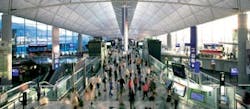These are tough times. The world recession is biting deep and plunging traffic figures are piling on the pressure for airlines, airports and suppliers alike, all of which already operate on thin margins.
Even the Asia-Pacific region is feeling the pinch. Set to become the biggest aviation market in 2010, in January 2009 the number of international passengers carried by members of the Association of Asia Pacific Airlines (AAPA) fell 7.8 percent to 11.4 million. Compared to the same month last year, load factors were down to 73.9 percent while freight ton kilometers dropped an astounding 23.6 percent.
“The operating environment remains extremely challenging,” says Andrew Herdman, AAPA director general. “The collapse in world trade is having a severe impact on air freight demand, forcing airlines to temporarily ground a number of dedicated freighter aircraft. Passenger travel demand is also weak, with premium traffic particularly hard hit as businesses seek to cut costs in response to the global economic downturn.”
Asia-Pacific is no stranger to such turmoil, having gone through the Asian Financial Crisis in the late 1990s and then SARs. Its battle-hardened nature is further strengthened by the intense competition in the area, with five-star hubs and carriers trying to gain market share against equally eminent rivals.
Indeed, the quality of airports in the region is such that most European or North American gateways feature way down on any honor roll. In 2008, the top four places in the Skytrax “World’s Best Airport” awards were Asian. Kuala Lumpur International Airport came fourth, Seoul Incheon International Airport was third, and Singapore Changi Airport ranked second. The winner, for the seventh time in eight years, was Hong Kong International Airport (HKIA).
Building for the future
Not that the airport is resting on its laurels. It has recently renovated its departure area in Terminal 1, increasing the number of security channels to enhance customer service. The project is part of a $4.5 billion program, which will also construct a new North Satellite concourse, a SkyPier ferry terminal and add new transfer desks, immigration counters and expanded baggage handling capabilities.
The bulk of the money, however, is being spent on the airfield. Ten new cargo stands have been built, there is a new fuel farm, the airport’s two runways have been resurfaced and two rapid exit taxiways are coming into operation.
Then there are the government-led infrastructural projects such as the Hong Kong-Zhuhai-Macao Bridge and Tuen Mun-Chek Lap Kok link. A feasibility study will assess the possibility of a rail connection between HKIA and Shenzhen Airport.
Beyond this, HKIA has appointed Maunsell Consultants Asia Ltd. as lead consultant for its Master Plan 2030, aimed at ensuring the airport keeps its place among the very best in the world. The study will make a comprehensive assessment of the airport’s operational requirements and constraints, in theory allowing HKIA to achieve the best possible balance between airport operations, aviation support and airport-related development.
“The plan will review and recommend the optimal airport layout and land-use development, including the possibility of building a third runway and its supporting facilities and infrastructures,” says Stanley Hui Hon-chung, chief executive officer of the Airport Authority.
The work should come in handy. Flying in the face of current trends, HKIA recorded a slight increase in passenger traffic in January 2009, although cargo was hit hard. Overall in 2008 it managed a 1.7 percent increase in passenger throughput and a 3.1 percent decline in cargo traffic as compared to 2007, reaching 48.6 million and 3.6 million tons, respectively. Air traffic movements grew 2 percent to 301,285.
If its public face is impressive, the work going on behind the scenes is no less formidable. The ground support companies have a lot to live up to as the award-winning gateway surges toward the 50-million passengers per annum (mppa) mark but seem to be taking the task in their stride. For example, Hong Kong Air Cargo Terminals Ltd. (Hactl) — operator of SuperTerminal 1 at HKIA, the world’s largest single air cargo terminal — has recently become one of the first companies to be registered under IATA’s Safety Audit for Ground Operations (ISAGO).
Reflecting the industry
Ground handling companies at HKIA are being spurred on by competition. Much like their airport and airline partners, the fight to maintain and increase market share is a fierce one and only the best will survive.
“At HKIA, there are over 20 ground handling agents providing a range of aviation-related services including ramp operations, aircraft maintenance, cargo handling, airline catering, aviation fuel refilling and more,” informs an Airport Authority (AA) spokesperson. “We do not set an optimum number of agents for various services. We intend to provide users of the airport with a choice of service providers and ensure there are sufficient service providers to meet the needs of airport users.
“For example, there are three ramp handlers and three aircraft line maintenance operators at HKIA,” he continues. “In general, these services are non-exclusive and the Airport Authority would introduce additional operators, dependent upon the operational and market needs of the time.”
The Airport Authority believes that by encouraging healthy competition, ground handling agents will compete with each other on service quality and pricing levels, thereby providing their customers with better service at a more competitive price.
During tender assessment, it evaluates the business proposal of franchisees/licensees, including bidding price, technical strength and manpower. Any contracts require the operators to meet a list of key performance indicators (KPIs) beyond the individual Service Level Agreements. A comprehensive monitoring system ensures there are no slackers.
The AA is even heating things up a little. In a recent “renewal” exercise, it included a requirement for using environmentally friendly equipment in its contracts. It has also updated some of the Key Performance Indicators and the spokesperson reveals “new standards will be introduced as necessary.”
Too hot to handle
But is it all becoming too hot to handle for the ground handling agents? Recent activity suggests so. Last year Menzies Aviation pulled out of Hong Kong, selling up to Singapore Air Terminal Services (SATS) for a reported HK$18 million (US$2.3 million).
SATS has taken full control of the passenger and ramp handling services for 11 airlines including Federal Express, Cebu Pacific, Air Canada, Orient Thai and Asiana Airlines. The company already provides cargo services at the airport and believes growing its share of the market will give airline customers a more coherent and efficient product.
Hong Kong Airport Services Ltd. (HAS) has also seen value in consolidation. It recently integrated with Hong Kong International Airport Services Ltd. to form one of the largest ground handling services companies in Asia. At HKIA, it provides passenger handling for 13 airlines, and ramp and cargo services for 37 airlines. On Dec. 1, 2008, it became a wholly owned subsidiary of home carrier, Cathay Pacific.
The “bigger is better” philosophy is not unique to HKIA. It can be seen on the global stage, with giants such as Swissport still viewing consolidation as a long-term trend, putting targets in Japan, South Korea and China on its Asian wish list.
Swissport recently pulled out of Singapore Changi. The company won some significant contracts as the new third licensee but not enough to make it pay against two well-established players, suggesting that size and significant market share really are all-important right now. If Swissport — for all its expertise and experience — can’t compete profitably, then there must be something in the theory.
The timings here may provide a clue to the story. Swissport started in Changi in 2005 — good times; it closed in 2009 — bad times. Maybe consolidation, size and significant market share are temporary strategies. They are not right per se — but they are right for now.
Size matters
Still, reaching a certain critical size does appear to matter. Most major gateways, despite processing large volumes of passengers and cargo, have relatively small numbers of ground handling agents. Providing an efficient service requires room to maneuver and that room is a precious commodity, not easily given up.
Home carriers tend to self-handle at their hubs and generally no more than a handful of independents make up the numbers. Amsterdam is one example with KLM and three others. And India recently tried to limit the number of ground service providers to three — albeit unsuccessfully in the face of union pressures.
At HKIA, the space and facilities are allocated according to the needs of the company, as far as that is possible. The AA constantly evaluates the demand for additional space and facilities to ensure that service quality is not compromised.
Being a relatively new airport — it opened in 1998 — HKIA was able to take into account the various operational requirements during the planning and construction phases. Ground handlers’ facilities and equipment are located as close to their customary operation areas as possible. “Meanwhile, new locations for holding their equipment have been allocated to suit the changing operational needs of ground handlers,” says the spokesperson.
A new plan of attack
HKIA seems to represent a new trend in the industry. Unbridled competition, it seems, isn’t necessarily the best way forward. Yes, there must be choice but that choice doesn’t need to be limitless — rather they must be viable options, each offering quality service at a cost-effective price. Value for money, in other words.
For ground handlers to be able to offer that to clients in the current environment means consolidation, the space to operate and enough clients to make the operation pay.
The challenge for them will be in staying lean and mean — growing fat and losing flexibility could be fatal — and looking for efficiencies wherever possible. HKIA has used radio frequency identification (RFID) baggage tags for more than a year and late last year spent HK$18 million on new self-service kiosks.
It seems Hong Kong International Airport — not to mention the industry — has learned its lessons. The free market is still there but it has self-adjusted, leaving better, more efficient ground handlers with the space to do their job properly. Post-recession, there will doubtless be a re-think but for now, big is beautiful.






